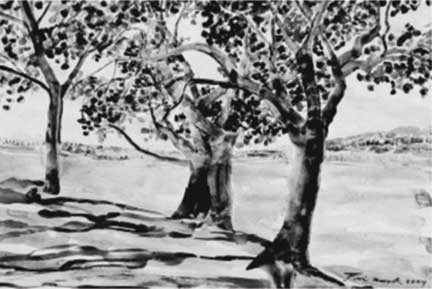The opening of the Robert Freimark exhibit at the Community and
Cultural Center last week was the first time that this facility has
been used to show the works of an artist of Freimark
’s stature.
The opening of the Robert Freimark exhibit at the Community and Cultural Center last week was the first time that this facility has been used to show the works of an artist of Freimark’s stature.
Daryl Manning, along with Sylvia Cook, are to be commended for arranging this show. It is something that this town and its artists’ community has long needed. It is also a long overdue recognition of our most important artist.
This exhibit consist of 30 watercolors of California landscapes. The earliest were dated 1979, the most recent were from this year. Throughout the exhibit, Freimark demonstrates an energy that belies his 82 years.
One can sense that energy in his 1979 piece, Uvas Canyon. It is still there in Reservation Road from this year. The energy is felt in every aspect of these works, from a rapid brush stroke to the strong diagonal lines of the trees.
Down Range/Coe, a 1986 landscape, epitomizes the ridges and hills that surround us in Morgan Hill.
It could have been a number of places, but was not. There is a specificity to the rendering of this scene that lets you know he was there. Coe Park is also the viewing point for one of the weakest works, Morgan Hill from Coe Peak.
Still, one should take some time with this piece to see what De Anza might have seen, a valley without a building.
This exhibit of Freimark’s work provides a glimpse of his versatility as an artist. From Blossom Valley at one end of the hall to Ocean at Pacific Grove, isolated near the Monterey Road entrance, you experience a range of landscape. Freimark is equally adept at capturing the feel of Elkhorn Slough as he is with more solid subject matter.
The same range is seen in the styles of the work, from the realism of Down Range/Coe to the abstracted patterns of My Backyard. What he has really captured is the relationship between the viewer and the land.
Freimark has also given us a set of Introductions to an exhibit.
They are worthy of careful reading, but I think not as an introduction. Rather, one should go back and read them after viewing the entire exhibit. Allow the works to, in Freimark’s words, “permeate your spirit.”
The “Introductions” are rather a statement of his personal philosophy, contrasting that connection with this landscape to the disconnected nature of the world in which too many live, especially our youth.
I personally hope that Morgan Hill’s newly elected school board will take the time to see this exhibit and to read the introductions.
It is unfortunate that the City of Morgan Hill found it necessary to put a sticker on the exhibit brochure stating that “The views expressed by the artist are not necessarily the views of the City.” We might have a better town if they were.
An exhibit of this quality really deserves to be hung in a better space. The Community and Cultural Center was not designed with gallery space. Most of the works were hung on the walls of a hallway, some directly over seats that, if in use when you walked by, were a visual obstruction. If you can not get too close to some, it is also not possible to put enough distance between the works and yourself to see them properly. To do that, you would have had to go outside and look through the windows.
Works which were soft and indistinct with this enforced close-range viewing revealed their strong, distinct construction when it is possible to see them from a proper distance. When it is quiet in the hallway, you should step back and see them as they are.
In spite of the problems with the venue, this is certainly the best exhibit that I have seen in the South Valley since returning to Morgan Hill in 1993.
With all of the stress of an election time just passed and of the holidays coming soon, it would do us all some good to see this exhibit and allow Frei-mark’s works to connect you again with the natural world we have all around us.
The exhibit will be on display through Jan. 14 at the Community and Cultural Center, Monterey Road and East Dunne Avenue.
“I find I have a great lot to learn, or unlearn. I seem to know far too much and this knowledge obscures the really significant facts, but I am getting on.” – Charles Rennie Mackintosh
Wes Rolley is a local artist








